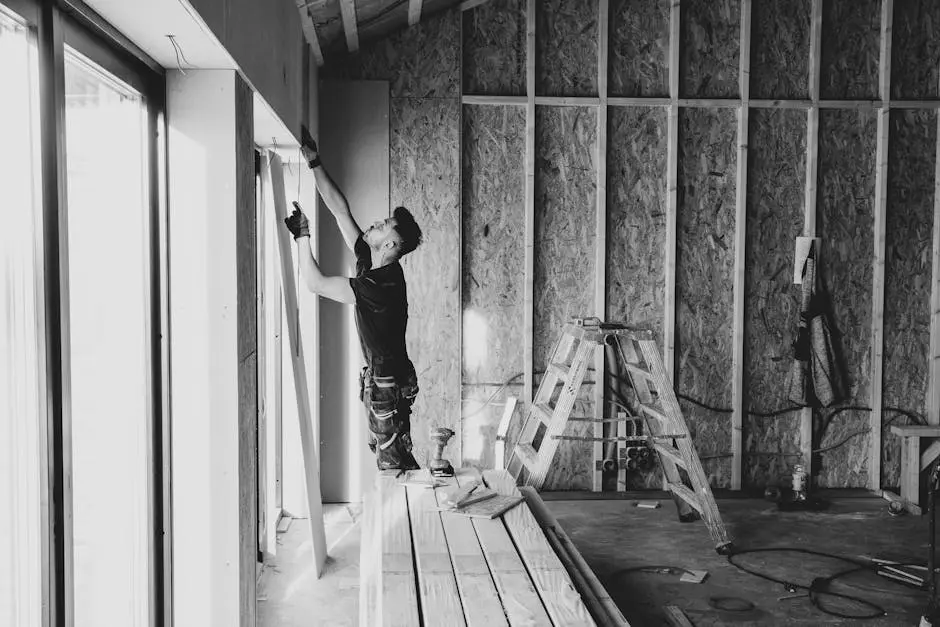Drywall sanding might seem straightforward, but it’s an art that requires a careful touch and attention to detail. In this guide, we’ll explore some of the most common mistakes people make and offer practical tips to help you achieve a smooth finish with confidence.
1. Over-Sanding the Surface
Over-sanding can lead to uneven surfaces and expose joint tape. The key is to sand just enough to smooth the surface without going too far.
It’s common to think that more sanding equates to a smoother finish, but this isn’t always the case. In fact, over-sanding can cause more harm than good, exposing the joint tape and resulting in an uneven surface that will show through paint. It’s crucial to apply just the right amount of sanding pressure—enough to smooth the surface without overdoing it. A helpful tip is to lightly sand the seams and raised areas while keeping the overall surface uniform. This balanced approach ensures that you achieve a smooth finish without compromising the integrity of the drywall.
2. Skipping the Primer
Some might skip priming, thinking it’s unnecessary. However, primer is crucial for ensuring an even paint application and hiding joint compound.
The temptation to skip the primer layer might save you time initially, but it can cost you in the long run. Primer serves as a base coat that helps conceal the variations in joint compound and drywall texture, enabling the paint to adhere properly and prevent uneven absorption. This step is especially vital if you’re dealing with new drywall, where the porous surface can affect paint coverage. Applying a quality primer ensures that your final coat of paint looks crisp, vibrant, and professional.
3. Using the Wrong Sandpaper Grit
Using sandpaper that’s too coarse can create unwanted scratches, while too fine a grit might not effectively smooth the surface. Start with a medium grit and finish with fine grit for the best results.
Selecting the correct sandpaper grit is crucial for a flawless finish. Coarse grit sandpaper tends to leave scratches that become visible after painting, while overly fine grit can be inefficient, failing to smooth out significant imperfections in the drywall. A rule of thumb is to start with medium-grit paper, such as 120-grit, before finishing with a finer 150-grit or 220-grit sandpaper. This approach facilitates the removal of inconsistencies, while ensuring that the surface is smooth and prepared for painting.
4. Applying Excessive Pressure
Pressing too hard on the sandpaper can leave gouges. Let the sandpaper do the work, using a gentle touch to avoid damaging the wall.
A common mistake is to use excessive pressure when sanding drywall. People mistakenly believe that pressing harder will expedite the process, but this often results in gouges and uneven surfaces. The right technique is to use gentle, consistent pressure, letting the sandpaper do the work. A light touch allows the abrasive to shear off the imperfections without digging into the drywall, resulting in a more even finish. Utilizing a sanding block can provide a more even distribution of pressure, preventing accidental gouging and contributing to a smoother wall.
5. Neglecting to Use a Pole Sander
A pole sander helps reach high spots and provides even pressure. It’s a valuable tool that can make the job easier and more efficient.
The convenience of a pole sander can’t be overstated, especially for large wall spaces and ceilings. Its extendable handle allows you to comfortably reach higher areas without the need for ladders, while its swivel head maintains consistent contact with the wall. Pole sanders are particularly effective for preventing pressure points that can result from hand sanding, offering a smoother and more even finish. Investing in a quality pole sander not only makes the process more efficient but also reduces the physical strain associated with large-scale sanding projects.
6. Ignoring Dust Management
Sanding creates a lot of dust, which can interfere with the final finish. Use a vacuum sander or consistently clean up dust with a damp cloth.
One of the critical aspects of drywall sanding is effective dust management. Dust can quickly accumulate, obscuring your view of the surface and leading to finish imperfections. Utilizing a vacuum sander attachment can significantly reduce airborne dust and keep your workspace clean. Alternatively, frequently wiping down surfaces with a damp cloth helps maintain visibility, ensuring that errors are caught and corrected early. Effective dust management not only improves the quality of the finish but also contributes to healthier working conditions, minimizing respiratory risks associated with drywall dust inhalation.
7. Not Sanding Between Coats
Each layer of joint compound should be lightly sanded to blend seams and remove imperfections, ensuring a uniform finish.
Sanding between joint compound layers ensures that each coat builds uniformly upon the previous one. This step is crucial for blending seams and eliminating imperfections like ridges or bubbles. Utilizing a fine-grit sandpaper and gentle pressure, you can smooth out each layer seamlessly, preparing the wall for the topcoat of paint. Skipping this step may leave noticeable flaws in the finish that become impossible to correct once painted. This attention to detail not only elevates the quality of the drywall finish but also extends the longevity of the paint job.
8. Sanding in Low Light
Good lighting is essential for spotting imperfections. Make sure your workspace is well-lit to avoid missing any spots that need attention.
Working under inadequate lighting conditions can result in missed imperfections that become glaringly obvious once the room is fully illuminated or painted. Utilizing portable work lights or natural sunlight can highlight discrepancies in texture and smoothness. Adequate lighting not only aids in the detection of flaws but also enhances the overall accuracy of the sanding process. This foresight ensures a quality finish and mitigates the need for additional touch-ups after painting.
9. Neglecting Edge and Corner Sanding
Edges and corners are often overlooked but require just as much attention. Use a sanding sponge to get into these tight spots.
Edges and corners present unique challenges in drywall sanding, often going unnoticed in favor of the larger wall surfaces. However, thorough sanding of these areas is indispensable for achieving a professional-looking finish. Utilizing a sanding sponge allows you to reach tight corners and intricate edges, ensuring these spots receive the same attention as the broader surfaces. The flexibility of a sanding sponge adapts to unique angles and contours, helping eliminate rough patches or excess joint compound that may have accumulated. Dedicating time to these areas pays off by presenting a more cohesive and polished appearance once the room is painted.
10. Rushing the Sanding Process
Patience is key in drywall sanding. Take your time to ensure each section is adequately smoothed and prepared for painting.
The rush to complete a project can lead to cutting corners, but hurried sanding often results in a subpar finish. Patience and thoroughness stand as guiding principles in achieving a high-quality job. Allow ample time for inspection and re-sanding if necessary, to address and correct any imperfections before moving on to priming and painting. Approaching the task with meticulous care produces smooth, evenly prepared surfaces ready for a flawless paint application. This disciplined approach not only elevates the room’s aesthetic but also embodies craftsmanship excellence.












